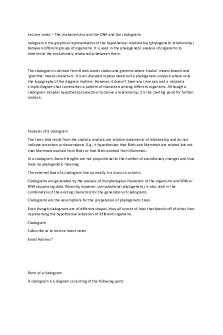Lecture notes - The Habitat and Morphology of Chlamydia trachomatis PDF

| Title | Lecture notes - The Habitat and Morphology of Chlamydia trachomatis |
|---|---|
| Course | Biology |
| Institution | University of Salford |
| Pages | 2 |
| File Size | 33.1 KB |
| File Type | |
| Total Downloads | 83 |
| Total Views | 137 |
Summary
Lecture notes based on The Habitat and Morphology of Chlamydia trachomatis are useful for exams...
Description
Lecture notes - The Habitat and Morphology of Chlamydia trachomatis Habitat of Chlamydia trachomatis It is an obligate intracellular human pathogens. Humans are the only natural host. It cannot survive outside of a eukaryotic host. Chlamydia trachomatis is transmitted by oral, vaginal or anal sex, and can also be transmitted from mother to newborn during a vaginal delivery. They can cause discharge from the penis, pain and burning during urination, infection or inflammation in the ducts of testicles, and tenderness or pain in the testicles. Habitat and Morphology of Chlamydia trachomatis
The Morphology of Chlamydia trachomatis It is a weak Gram-negative bacteria. It also contains LPS, which helps cause damage to the host’s body. It lacks a peptidoglycan cell wall. It lacks muramic acid that is found in the cell walls of most other bacteria. It is non-sporing. They are non-motile. It has a coccoid or rod shape. They exist in two morphological forms: small infectious elementary bodies 300 nm – 400 nm in diameter and larger replicating reticulate bodies 800 nm – 900 nm in size. The elementary body is the dispersal form, which is analogous to a spore. The dispersal form is about 0.3 um in diameter. The reticulate body divides through binary fission at approximately 2-3 hours per generation. The reticulate body has an incubation period of 7-21 days in the host. The reticulate body contains no cell wall and is detected as an inclusion in the cell.
The Genome of Chlamydia trachomatis It have an extra-chromosomal plasmid. It has a genome that consists of 1,042,519 nucleotide base pairs. It has approximately 894 likely protein coding sequences.
All the isolates are about 7,500 nucleotides long. It has eight open reading frames computer-predicted to code for proteins of more than 100 amino acids....
Similar Free PDFs

The Handbook of Morphology
- 392 Pages

4 Morphology - Lecture notes 4
- 9 Pages

Syntax and Morphology -
- 46 Pages

Inflection and derivation morphology
- 14 Pages

Resumen habitat
- 78 Pages

mycoplasma ureaplasma chlamydia
- 3 Pages
Popular Institutions
- Tinajero National High School - Annex
- Politeknik Caltex Riau
- Yokohama City University
- SGT University
- University of Al-Qadisiyah
- Divine Word College of Vigan
- Techniek College Rotterdam
- Universidade de Santiago
- Universiti Teknologi MARA Cawangan Johor Kampus Pasir Gudang
- Poltekkes Kemenkes Yogyakarta
- Baguio City National High School
- Colegio san marcos
- preparatoria uno
- Centro de Bachillerato Tecnológico Industrial y de Servicios No. 107
- Dalian Maritime University
- Quang Trung Secondary School
- Colegio Tecnológico en Informática
- Corporación Regional de Educación Superior
- Grupo CEDVA
- Dar Al Uloom University
- Centro de Estudios Preuniversitarios de la Universidad Nacional de Ingeniería
- 上智大学
- Aakash International School, Nuna Majara
- San Felipe Neri Catholic School
- Kang Chiao International School - New Taipei City
- Misamis Occidental National High School
- Institución Educativa Escuela Normal Juan Ladrilleros
- Kolehiyo ng Pantukan
- Batanes State College
- Instituto Continental
- Sekolah Menengah Kejuruan Kesehatan Kaltara (Tarakan)
- Colegio de La Inmaculada Concepcion - Cebu









